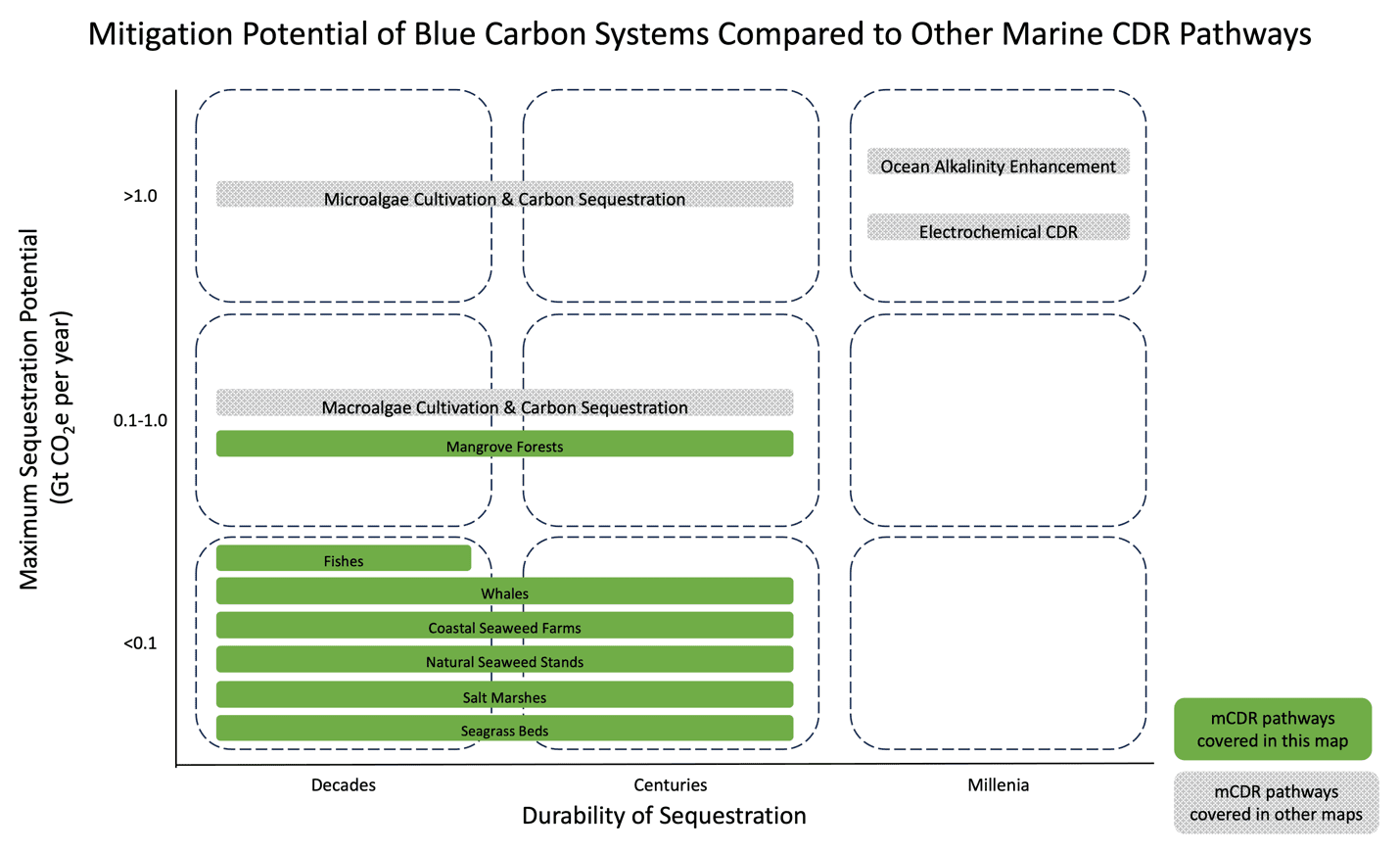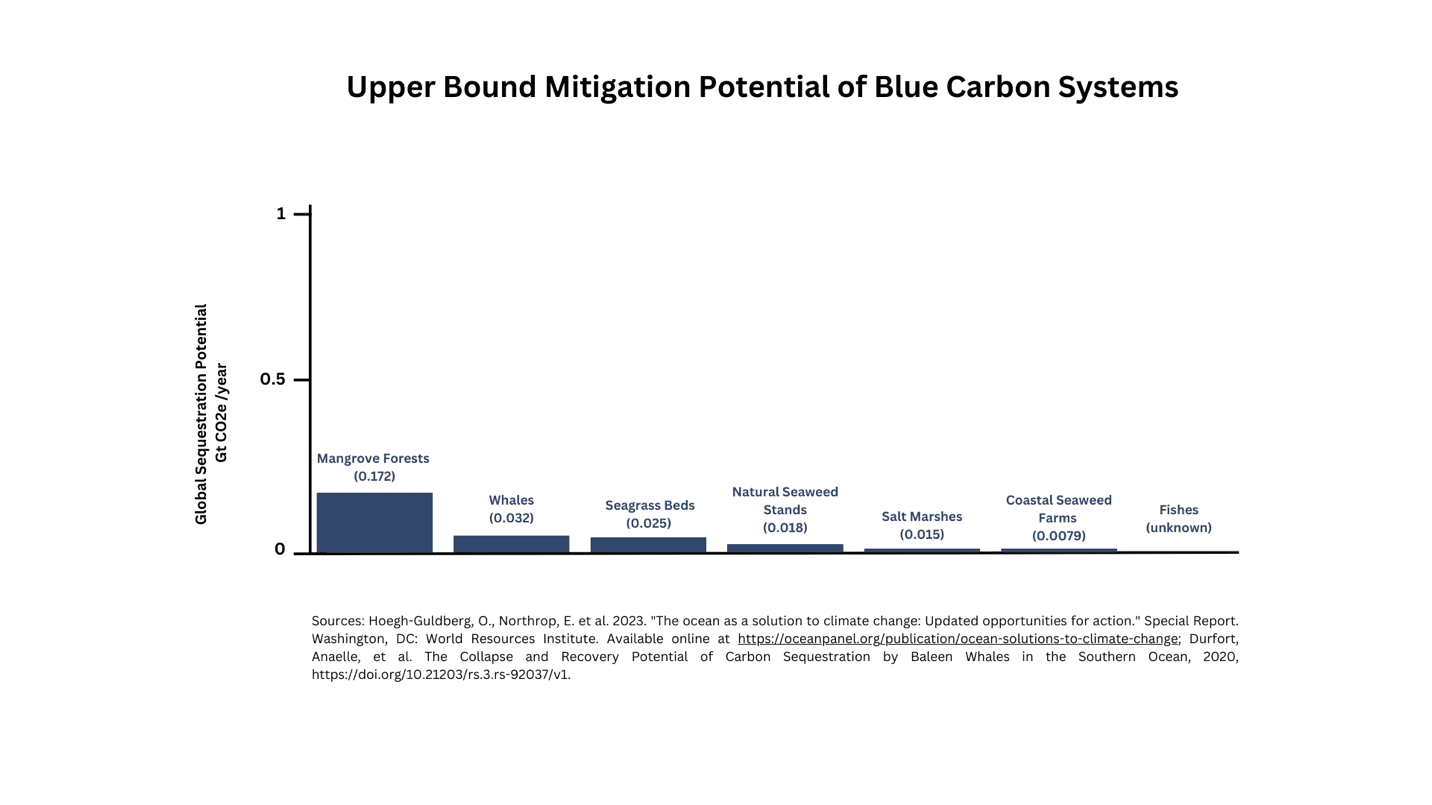 Introduction to the Road Map
Introduction to the Road Map
Overview
Carbon dioxide removal (CDR) is a term used to describe anthropogenic activities that directly or indirectly remove carbon dioxide (CO2) from the atmosphere and durably store it in geological, terrestrial, or ocean reservoirs, or in products. Marine carbon dioxide removal (mCDR) is a subset of CDR approaches that leverage the ocean to remove CO2 and/or store captured CO2 in ocean reservoirs.
The term “blue carbon” has historically referred to three (vascularly) vegetated coastal ecosystems: mangrove forests, salt marshes, and seagrass beds (Lovelock & Duarte, 2019). These ecosystems are among the most productive in the world (NASEM, 2019) and sequester carbon in their underlying substrates (e.g., soil or sediment). Estimates of their global distribution reach ~36-185 million hectares, storing as much as 33 billion tons of carbon (Macreadie et al., 2021), however there remain large knowledge gaps around spatial extent and storage capacity, owing to the high variability across regions and ecosystems. The carbon in the substrate can be stored as organic or inorganic carbon and can remain sequestered for millennia (Macreadie et al., 2021; Duarte et al., 2013), positioning these ecosystems as important parts of the global carbon cycle. Situated between land and water, these ecosystems also play critical roles in human society and provide many services including coastal buffering from storms, surges and erosion control generally, nursery grounds for fish, culturally significant sites, and sources of income from fishing and tourism. Blue carbon ecosystems have gained attention as levers for climate change mitigation, including carbon sequestration (Collins et al., 2022).
Some of this attention is related to the major uptick in interest and attention around carbon dioxide removal (CDR)[7]“Anthropogenic activities removing CO2 from the atmosphere and durably storing it in geological, terrestrial, or ocean reservoirs, or in products. It includes existing and potential anthropogenic enhancement of biological or geochemical sinks and direct air capture and storage, but excludes natural CO2 uptake not directly caused by human activities.” https://www.ipcc.ch/sr15/chapter/glossary/ , which has again raised questions about the capacity of blue carbon ecosystems to sequester carbon and combat climate change (Collins et al., 2022; NASEM, 2022; Cross et al., 2023; NASEM, 2019). This discussion has also broadened the conversation around the definition of blue carbon, with the IPCC (2019) defining blue carbon as ‘all biologically driven carbon fluxes and storage in marine systems that are amenable to management’ (IPCC, 2019). This definition can and has been interpreted to encompass not only coastal vegetated ecosystems that store carbon in their structure and sediments, but also other marine life such as fish and mammals, as well as natural seaweed stands and seaweed farms – all systems that not only store and recycle carbon through their living tissues, but also respond to anthropogenic manipulation and management. Two notable examples of this broadened definition include the National Academies of Sciences, Engineering, and Medicine’s (NASEM) 2022 report on ocean carbon dioxide removal in which they include a chapter on “Recovery of Marine Ecosystems” for CDR (including benthic, pelagic, and offshore ocean systems along with mangrove forests, salt marshes, and seagrass beds) and the National Oceanographic and Atmospheric Administration’s (NOAA) 2023 Strategy for Carbon Dioxide Removal Research which includes coastal blue carbon (defined as mangrove forests, salt marshes, and seagrass beds) as well as ‘Marine Ecosystem Recovery’ (fishes and marine mammals). (Also note NOAA, 2021, and a recent call for a broader definition of ‘blue carbon ecosystems’ by James et al., 2024)).
Following these recent advances, this road map will consider carbon stored in natural seaweed stands and in marine animals (e.g., fishes and mammals) in the definition of blue carbon, alongside mangrove forests, salt marshes, and seagrass beds. Natural seaweed stands and marine animals have received substantially less attention as potential pathways for additional carbon dioxide sequestration and will require accelerated research to determine their potential. The nascent nature of these pathways makes them particularly well suited to be assessed in this road map.
Note: While the blue carbon definition above could be interpreted to include microalgae cultivation, we have excluded it from consideration in this road map because we have already released a road map for Microalgae Cultivation and Carbon Sequestration. In addition, we limit discussion of seaweed (macroalgae) farms to coastal farms which passively sequester carbon through biomass export to underlying sediments or offshore to deeper waters. We exclude discussion of seaweed farming coupled to active sequestration (such as sinking or harvesting to produce biochar) because this topic is covered in a different road map, Macroalgae Cultivation and Carbon Sequestration.
This road map focuses on assessing the potential for blue carbon to contribute to carbon dioxide removal (CDR), or the additional sequestration of carbon, and what is needed to achieve that potential. In many cases, this will look like the large-scale restoration of ecosystems or rebuilding of animal populations (and, in some cases, expansion of ecosystems or animal populations beyond past limits). Recent work by the Environmental Defense Fund and the High Level Panel for a Sustainable Ocean Economy suggests that even the most rigorous and optimistic future estimates of blue carbon restoration may yield small gains in additional carbon sequestration when compared with the scale of anthropogenic emissions and other possible CDR pathways (Fujita et al., 2022; Collins et al., 2022a; Collins et al., 2022b; Hoegh-Guldberg et al., 2023). One reason for this is the spatial limitation presented by the restoration of coastal vegetated ecosystems (i.e., mangrove forests, seagrass beds, and salt marshes). These ecosystems have spatial limits on their potential for restoration, and thus, their potential for carbon removal, however, other sources of blue carbon, such as animal biomass and seaweed farms, are far less limited by spatial constraints. Moreover, blue carbon restoration offers low or no-risk pathways, which sets it apart from other proposed CDR solutions. Not only do restoration efforts of blue carbon pose fewer risks to the environment and society than other proposed CDR solutions, but they also offer an enormous capacity for other benefits to both ecosystems and communities. In this way, carbon removal may in fact be best thought of as a “co-benefit” to blue carbon restoration and efforts (Williamson & Gattuso, 2022). Regardless, there is still critical research that would increase our understanding of the role blue carbon plays in the carbon cycle and inform responsible decision-making at the ocean-climate nexus.
In light of current and future climate disruption and risk, there is a growing need for solutions that will help to remove and durably store legacy greenhouse gas emissions. However, there remains a substantial set of unanswered questions around the capacity and efficacy of carbon storage in blue carbon systems. As scientists, practitioners, and policymakers continue investigating blue carbon as a climate solution, it is critical to be clear about what is known, and what remains unknown, and identify a pathway by which to answer the most important outlying questions. This road map lays out the current state of knowledge around carbon sequestration and storage in blue carbon systems, details the most pressing unanswered questions to understand the potential for blue carbon sequestration, and proposes ways in which to accelerate the development and testing of these potential solution pathways.
A Note on Restoration vs. Protection
Protection of existing blue carbon ecosystems and their embedded carbon avoid emissions generated as these systems degrade. This is complementary and distinct from the restoration of blue carbon systems, which is the regrowth of these ecosystems. This regrowth is where additional carbon can be sequestered. Because the focus of this road map is the potential for blue carbon systems to contribute to carbon dioxide removal, this map will only focus on restoration efforts, their state of progress, challenges, knowledge gaps, and opportunities to drive forward progress.
A Note on Units of Measurement
This road map differs from the other Ocean Visions’ Ocean CDR Road Maps in its use of ‘Gigaton CO2 equivalent’ (Gt CO2e) in order to account for the important role played by non-CO2 greenhouse gases (e.g., methane, CH4, and nitrous oxide, N2O) within blue carbon systems. Although petagrams (Pg) is a unit commonly used in blue carbon literature, we use the equivalent gigatons (or gigatonnes; Gt) in this road map.
The Environmental Defense Fund published three detailed reports in 2022 on “Natural Climate Solutions” that examine the roles that coastal blue carbon, natural seaweed stands, and marine animals may play in the overall climate solutions landscape, including, but not limited to, carbon removal. For more in-depth reading about any one of these systems and the other roles they can play beyond carbon removal, we recommend exploring the recent suite of detailed reports (linked below) as well as the many cited papers throughout this road map. There are also several other resources embedded in this road map including links to blue carbon working groups around the globe where current research and work is happening and interactive maps showing known extents of blue carbon habitats.
|
Summary Figures
Figure 1

Sources: Hoegh-Guldberg, O., Northrop, E. et al. 2023. “The ocean as a solution to climate change: Updated opportunities for action.” Special Report. Washington, DC: World Resources Institute. Available online at https://oceanpanel.org/publication/ocean-solutions-to-climate-change; National Academies of Sciences, Engineering, and Medicine 2022. A Research Strategy for Ocean-based Carbon Dioxide Removal and Sequestration. Washington, DC: The National Academies Press. https://doi.org/10.17226/26278.0
Figure 2

Visual of Environmental Co-Benefits Across Blue Carbon Systems
|
Environmental Co-Benefits
|
|||||||||||
|
Co-Benefit |
System
|
||||||||||
|
Animal Carbon |
Natural Seaweed Stands |
Mangrove Forests |
Salt Marshes |
Seagrass Beds |
|||||||
|
Amelioration of ocean acidification |
|
(Mongin, 2016)
|
(Banjeree & Paul, 2022)
|
|
(Ricart et al., 2022; Koweek et al. 2018)
|
||||||
|
Potential for ocean alkalinity enhancement |
|
|
(Fakhraee et al., 2023)
|
|
(Fakhraee et al., 2023)
|
||||||
|
Contribution to biodiversity
|
|
(Theuerkauf et al., 2021)
|
|
(Thrush et al., 2013; Esteves 2014)
|
(McHenry et al. 2021)
|
||||||
|
Contribution to habitat provisioning
|
|
(Langton et al., 2019) |
|
|
|
||||||
|
Contribution to heavy metal and nutrient pollution removal
|
|
(Zheng et al, 2019; Jiang et al., 2020)
|
|
|
(Lee et al. 2019)
|
||||||
|
Contribution to fishery enhancement
|
|
(Rimmer et al., 2021; Theuerkauf et al., 2021)
|
|
|
(Orth et al., 2006)
|
||||||
|
Improved water clarity through the facilitation of settlement of fine sediments
|
|
(Jiang et al., 2020)
|
|
|
|
||||||
|
Coastal protection against erosion and/or sea level rise |
|
(Elsmore et al., 2023) |
(Barbier et al., 2011)
|
(Barbier et al., 2011)
|
(Barbier et al., 2011, Duarte et al. 2013)
|
||||||
|
Nutrient cycling |
(Le Mézo et al. 2022; Ratnarajah et al., 2014)
|
(Cotas et al., 2023)
|
(Mitra 2019) |
(Sousa et al., 2010)
|
(Orth et al., 2006) |
||||||
|
Reducing biodiversity loss
|
|
(NASEM 2022 mCDR)
|
(NASEM 2022 mCDR)
|
(NASEM 2022 mCDR)
|
(NASEM 2022 mCDR)
|
||||||
|
Restoring the role of marine organisms in the carbon cycle |
(NASEM 2022 mCDR)
|
(NASEM 2022 mCDR)
|
(NASEM 2022 mCDR)
|
(NASEM 2022 mCDR)
|
(NASEM 2022 mCDR)
|
||||||

How to submit comments:
Thanks for helping to advance these roadmaps. Here is how it works!
Or, send general feedback to info@oceanvisions.org
All submitted comments will be reviewed by the Ocean Visions team to ensure that they are true, verifiable, and additive before being added to the road maps. You can increase the likelihood that your comments will be incorporated into the road maps by providing references (where appropriate).